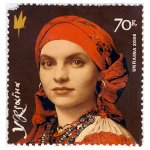Ukrainian Headscarf Day Date in the current year: December 7, 2025
 Ukrainian Headscarf Day, sometimes referred to as World Ukrainian Headscarf Day, is observed in Ukraine and by the Ukrainian diaspora on December 7. It celebrates an integral element of the Ukrainian folk costume.
Ukrainian Headscarf Day, sometimes referred to as World Ukrainian Headscarf Day, is observed in Ukraine and by the Ukrainian diaspora on December 7. It celebrates an integral element of the Ukrainian folk costume.For centuries, married women in Ukraine were expected to cover their hair with a headscarf (khustka) for modesty. Young unmarried women didn’t have to wear a headscarf, but they often chose to wear one to protect their hair from the cold in winter and from the heat and dust in summer. Unlike married women, young girls didn’t try to hide all their hair under a headscarf.
Married women wore a headscarf on its own or over a special headdress called an obrus. They usually folded a square headscarf diagonally before wrapping it over the head. A headscarf could be tied in the front or wrapped around and tied on the back; sometimes women crossed the ends of a large headscarf at the front of the neck but didn’t tie them, letting them hang loose on the back. Unmarried women often wrapped a headscarf around the had like a wreath, leaving the crown uncovered.
The headscarf was a marker of a woman’s social status and her family’s wealth. Young women usually wore white or brightly colored headscarves, older women wore dark headscarves, and widows wore black headscarves. Wealthy women could afford expensive silk headscarves, while women from low- and modest-income families mostly wore linen headscarves.
Headscarves were worn by women throughout Ukraine, but each region had its own traditional colors, patterns and methods of tying headscarves. Traditional headscarves were widely used in various rituals, especially those associated with betrothal and wedding. For example, a woman gave a headscarf to a man when accepting his marriage proposal. During the wedding, the newlyweds accepted gifts and money from guests through a headscarf to protect themselves from jinxes.
Some regions had local varieties of ritual headscarves. In Podilia, each guest at a wedding was given a homespun headscarf called a naframitsa or a shervet. In Bukovina, a betrothed girl was expected to embroider a special headscarf called a shirinka and give it to her fiance before the wedding.
Ritual headscarves weren’t exclusively used in wedding ceremonies. For example, at christenings, headscarves were tied to the godparents’ and the priest’s wrists. At funerals, everyone present was given a headscarf, a memorial candle was held through a headscarf, and the eyes of the deceased were covered with a headscarf.
The inaugural Ukrainian Headscarf Day was celebrated on December 7, 2019. It was initiated by a group of women’s rights activists from Vinnytsia, which included members of the regional legislative assembly, university lecturers, actresses, and representatives of the Club of Successful Women of Ukraine.
Although it has no official status and isn’t quite as popular as Vyshyvanka Day, Ukrainian Headscarf Day events are organized in many Ukrainian cities, towns and villages. The easiest way to join the celebration is take a selfie wearing a traditional Ukrainian headscarf and share it on social media to spread the word.
- Category
- Cultural Observances, Unofficial Holidays
- Country
- Ukraine
- Tags
- Ukrainian Headscarf Day, holidays in Ukraine, cultural observances, unofficial holidays, Ukrainian folk costume